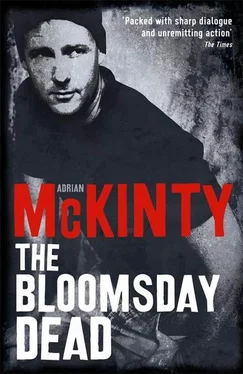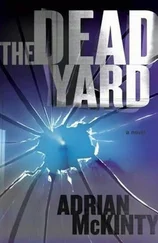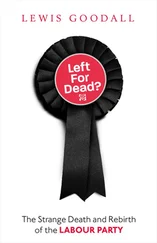Adrian McKinty - The Bloomsday Dead
Здесь есть возможность читать онлайн «Adrian McKinty - The Bloomsday Dead» весь текст электронной книги совершенно бесплатно (целиком полную версию без сокращений). В некоторых случаях можно слушать аудио, скачать через торрент в формате fb2 и присутствует краткое содержание. Жанр: Триллер, на английском языке. Описание произведения, (предисловие) а так же отзывы посетителей доступны на портале библиотеки ЛибКат.
- Название:The Bloomsday Dead
- Автор:
- Жанр:
- Год:неизвестен
- ISBN:нет данных
- Рейтинг книги:3 / 5. Голосов: 1
-
Избранное:Добавить в избранное
- Отзывы:
-
Ваша оценка:
- 60
- 1
- 2
- 3
- 4
- 5
The Bloomsday Dead: краткое содержание, описание и аннотация
Предлагаем к чтению аннотацию, описание, краткое содержание или предисловие (зависит от того, что написал сам автор книги «The Bloomsday Dead»). Если вы не нашли необходимую информацию о книге — напишите в комментариях, мы постараемся отыскать её.
The Bloomsday Dead — читать онлайн бесплатно полную книгу (весь текст) целиком
Ниже представлен текст книги, разбитый по страницам. Система сохранения места последней прочитанной страницы, позволяет с удобством читать онлайн бесплатно книгу «The Bloomsday Dead», без необходимости каждый раз заново искать на чём Вы остановились. Поставьте закладку, и сможете в любой момент перейти на страницу, на которой закончили чтение.
Интервал:
Закладка:
“You’re not getting in,” one of the Boys was saying to him.
“Aye, no fucking way,” said the other.
“We’re shutting the gates,” a third managed between belches.
The man in the green sweater did not seem that put out. Right in front of me, another of the Apprentice Boys climbed on top of a parked car and began stamping on the roof. It had an Irish Republic license plate and the Boy was obviously under the impression that it, too, was a representative of King James’s Catholic army. A peeler went over and told him to get down. The peeler was old, fat, and bored. He tapped his service revolver once and the Boy, spooked, got off the roof.
“Right, that’s it, I think you’re all through,” an inspector shouted and waved for the other coppers to reopen the streets. They began lifting the yellow tape.
“Black bastards,” the other Boys yelled in protest. “Black bastard” not a comment on race but rather on the policemen’s very dark green uniform, which appeared black. Indeed, in Northern Ireland the small number of foreign immigrants gave the wannabe racist scant opportunities. There was a sizable Chinese community, although racists tended to ignore them for fear that each one was a potential Bruce Lee who would kick their shit in.
The Boys refused to get off the street and the peels had to send in the riot police. While I waited to get going, I asked one of the school-girls if she knew where the Malt Shop was-a pretty brunette who looked as if she had never been exposed to sunshine in her life.
“Aye,” she said, looking to make sure her friends weren’t too far away. “You’re going the right direction but it’s on the other side of the street, just past the Ulster Bank.”
“Thanks very much.”
“No problem, although I tell ya, I wouldn’t go in there if I were you,” she said, her big brown eyes blinking slowly.
“Why’s that?”
“You a tourist? Are you from America?”
“No, well, sort of, I am from out of town,” I admitted.
“If you want a milk shake go to McDonald’s, that place is a bit dodgy,” the girl said.
“Is it now? Like what? Drugs?”
“I don’t know. If you go looking for drugs you find them anywhere. ’Course they still do good milk shakes like.”
“Well, thanks for the tip.”
“I could do with a milk shake myself,” she said with something close to a giggle.
“Love, if I was ten years younger, had slept, was untroubled by heavies, and not trying to solve a missing person’s case before midnight, I would be honored to buy you a milk shake, but as it is…” I said, shrugged apologetically, saw the street was finally cleared, and hurried in the direction of the Ulster Bank.
I was down on the Golden Mile now.
Belfast was mostly a nineteenth-century phenomenon, a side effect of a booming linen industry, docks, and shipyard. Its population had increased tenfold in less than a hundred years. Catholics flooding to certain sectors of the town, Protestants to others; and it has remained a segregated city. Prod and RC sections as clearly delineated as the black and white neighborhoods of Boston or Detroit. East Belfast: almost entirely Protestant. West Belfast, divided between a Protestant ghetto along the Shankill Road and a Catholic ghetto along the Falls Road. Impossible to wander into the wrong neighbor-hood by mistake. The Shankill Road bedecked with murals depicting various Protestant heroes, usually in the primary colors of red, white, and blue. The Falls Road had murals showing Catholic heroes, in green, white, and gold. The exception, however, was South Belfast. The area I was walking in right now. This part of the city was where the university district met the commercial heart. This was middle-and upper-class Belfast. Houses were more attractive, the streets were wider, trees didn’t get ripped to be turned into kindling around bonfire time and there were a lot of students, couples, and young people. Here there were no Protestant or Catholic bars. No murals, no flags, and little sectarianism.
But even so, you’d be kidding yourself if you thought the paramilitaries let these businesses thrive without interference. The Malt Shop would certainly be no exception.
“That must be it,” I said to myself as I caught a glimpse, three blocks ahead, of a miraculously unvandalized 1958 pink Cadillac that had been turned into an outside eating booth.
I jogged to the café with a feeling of urgency. Outside, three other cars that had been converted into tables. Another Caddy, a red Ford Thunderbird, and a distinctly anachronistic De Lorean. Despite the intermittent drizzle, all were packed.
I went in.
A large fifties-style diner, with a soda fountain, waiters on rollers skates, Buddy Holly on the jukebox, and other artifacts from the hazily misremembered days of the Eisenhower administration. The menu was standard diner fare with the occasional Ulster speciality such as deep-fried Mars bars served in a piece of soda bread. Completely bunged full of weans, enjoying malts and milk shakes.
A waitress in a nylon polka-dot dress and dreadlocks skated up to me.
“Help you?”
I took out the picture of Siobhan.
“I’m looking for this girl. She was seen with one of the regulars in here. Skinny ginger-haired kid. Ring any bells?”
The girl groaned. Clearly this wasn’t the first or even the second time someone had come by asking these questions. Bridget’s boys, the police, Bridget’s boys again, and the police again.
Well, they weren’t me.
“Listen, love, this is bloody serious, have you seen this girl?” I asked with an intimidating burr.
She shook her head.
“You’ll want to see the manager,” she said.
“Eventually,” I said. “I’ll show the photo around first.”
“You’re not allowed to bother the customers,” she said.
“Says who?”
There were at least three dozen people in the Malt Shop, not one over twenty-five. I showed them the photo, asked about the mysterious redheaded kid, but no one had seen a bloody thing. I tried my hand with the waiters and the dudes behind the counter, but again all I drew were blank expressions.
This in itself was a wee bit suspicious.
Nobody said, “Oh aye, she looks a bit familiar” or “A kid with red hair, aye, there’s a lot of kids with red hair” or “I think I might have seen her, did she have a wee dog?”
None of the usual stuff.
I mean, I know that Belfast people are very good at keeping their mouths shut, seeing nothing, and minding their own business. That’s why they had to replace jury trials with secret three-judge courts- no witnesses wanted to testify in front of twelve strangers and no juries wanted to convict terrorists who would come seeking revenge. And I know that Ireland has a well-established and long-standing culture of silence going back at least to the horror of informers during the 1798 Rebellion. But this was different. This was deeper. This was like everyone had been schooled. This was like the word had gone out.
And what had Bridget said? He had smelled of pot. And what the schoolgirl just told me? This place is druggie central. Aye, I could see that now. The paramilitaries ran this particular establishment with a grip of iron. There were probably a couple in here right at this very moment.
I sat down and ordered a malt.
The place began filling up with more schoolkids and students. A couple of cops came in, were given free malteds, and sat slurping them in the window seat. Useless wankers.
I found Dreadlocks again.
“Ok, love, go get the manager, I’ll talk to him now,” I said.
“He’s in a meeting.”
My eyes narrowed.
“Go get the manager,” I said very quietly.
“Ok,” she said.
Читать дальшеИнтервал:
Закладка:
Похожие книги на «The Bloomsday Dead»
Представляем Вашему вниманию похожие книги на «The Bloomsday Dead» списком для выбора. Мы отобрали схожую по названию и смыслу литературу в надежде предоставить читателям больше вариантов отыскать новые, интересные, ещё непрочитанные произведения.
Обсуждение, отзывы о книге «The Bloomsday Dead» и просто собственные мнения читателей. Оставьте ваши комментарии, напишите, что Вы думаете о произведении, его смысле или главных героях. Укажите что конкретно понравилось, а что нет, и почему Вы так считаете.










